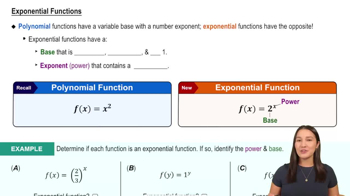Use the method of partial fractions to evaluate the integral.
Table of contents
- 0. Functions7h 54m
- Introduction to Functions16m
- Piecewise Functions10m
- Properties of Functions9m
- Common Functions1h 8m
- Transformations5m
- Combining Functions27m
- Exponent rules32m
- Exponential Functions28m
- Logarithmic Functions24m
- Properties of Logarithms36m
- Exponential & Logarithmic Equations35m
- Introduction to Trigonometric Functions38m
- Graphs of Trigonometric Functions44m
- Trigonometric Identities47m
- Inverse Trigonometric Functions48m
- 1. Limits and Continuity2h 2m
- 2. Intro to Derivatives1h 33m
- 3. Techniques of Differentiation3h 18m
- 4. Applications of Derivatives2h 38m
- 5. Graphical Applications of Derivatives6h 2m
- 6. Derivatives of Inverse, Exponential, & Logarithmic Functions2h 37m
- 7. Antiderivatives & Indefinite Integrals1h 26m
- 8. Definite Integrals4h 44m
- 9. Graphical Applications of Integrals2h 27m
- 10. Physics Applications of Integrals 3h 16m
- 11. Integrals of Inverse, Exponential, & Logarithmic Functions2h 34m
- 12. Techniques of Integration7h 41m
- 13. Intro to Differential Equations2h 55m
- 14. Sequences & Series5h 36m
- 15. Power Series2h 19m
- 16. Parametric Equations & Polar Coordinates7h 58m
12. Techniques of Integration
Partial Fractions
Problem 8.6.45
Textbook Question
7–84. Evaluate the following integrals.
45. ∫ from 0 to ln 2 [1 / (1 + eˣ)²] dx
 Verified step by step guidance
Verified step by step guidance1
Step 1: Recognize that the integral involves the function \( \frac{1}{(1 + e^x)^2} \). This suggests that substitution might simplify the problem. Look for a substitution that simplifies the denominator \( 1 + e^x \).
Step 2: Let \( u = 1 + e^x \). Then, differentiate \( u \) with respect to \( x \): \( \frac{du}{dx} = e^x \), or equivalently \( du = e^x dx \). Rewrite \( e^x dx \) in terms of \( u \).
Step 3: Substitute \( u \) into the integral. When \( x = 0 \), \( u = 1 + e^0 = 2 \). When \( x = \ln 2 \), \( u = 1 + e^{\ln 2} = 1 + 2 = 3 \). The integral becomes \( \int_{2}^{3} \frac{1}{u^2} \cdot \frac{du}{e^x} \). Since \( e^x = u - 1 \), replace \( e^x \) with \( u - 1 \).
Step 4: Simplify the integral to \( \int_{2}^{3} \frac{1}{u^2(u - 1)} du \). This integral can be solved using partial fraction decomposition. Express \( \frac{1}{u^2(u - 1)} \) as \( \frac{A}{u} + \frac{B}{u^2} + \frac{C}{u - 1} \), and solve for \( A \), \( B \), and \( C \).
Step 5: After finding the coefficients \( A \), \( B \), and \( C \), rewrite the integral as a sum of simpler integrals: \( \int \frac{A}{u} du + \int \frac{B}{u^2} du + \int \frac{C}{u - 1} du \). Evaluate each term separately and apply the limits of integration \( u = 2 \) to \( u = 3 \).
 Verified video answer for a similar problem:
Verified video answer for a similar problem:This video solution was recommended by our tutors as helpful for the problem above
Video duration:
9mPlay a video:
Was this helpful?
Key Concepts
Here are the essential concepts you must grasp in order to answer the question correctly.
Definite Integrals
A definite integral calculates the accumulation of a quantity, represented as the area under a curve, between two specified limits. In this case, the integral from 0 to ln 2 indicates that we are interested in the area under the curve of the function 1 / (1 + eˣ)² from x = 0 to x = ln 2.
Recommended video:

Definition of the Definite Integral
Integration Techniques
To evaluate integrals, various techniques can be employed, such as substitution, integration by parts, or recognizing standard forms. For the given integral, a substitution involving the exponential function may simplify the process, allowing for easier integration of the function.
Recommended video:

Integration by Parts for Definite Integrals
Exponential Functions
Exponential functions, such as eˣ, are fundamental in calculus due to their unique properties, including their derivatives and integrals being proportional to the function itself. Understanding how to manipulate and integrate these functions is crucial for solving integrals involving eˣ, as seen in the integrand of the given problem.
Recommended video:

Exponential Functions

 1:07m
1:07mWatch next
Master Partial Fraction Decomposition: Distinct Linear Factors with a bite sized video explanation from Patrick
Start learningRelated Videos
Related Practice
Multiple Choice
85
views
